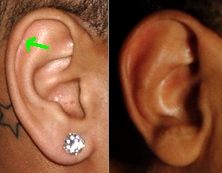Darwin's tubercle: The myth
Some people have a small bump on the inside of their upper ear. This is known as "Darwin's tubercle," or "Darwin's bump," because Charles Darwin mentioned it in his book The Descent of Man (Darwin 1879). Darwin's tubercle is sometimes used to illustrate basic genetics; the myth is that it is controlled by a single gene with two alleles, and the allele for Darwin's tubercle is dominant. The data in the only two genetic studies on this trait show that the myth is not true, so I'm not sure how the myth got started.
The reality
Darwin's tubercle as a character
About 10 percent of Spanish adults (Ruiz 1986), 40 percent of Indian adults (Singh and Purkait 2009), and 58 percent of Swedish schoolchildren (Hildén 1929) have this trait. Singh and Purkait (2009) divide the tubercle into "nodosity", "enlargement" and "projection." The differences among these are not obvious. When I look at ears, some people have a very obvious bump, while others have just a slight swelling on the margin of the ear; I think it would be difficult to cleanly divide ears into two categories, with or without Darwin's tubercle. In addition, some people have a bump on one ear but not the other (Quelprud 1936), and it is not clear how to classify them.
Family studies
Quelprud (1936) looked at presence (P) and absence (A) of Darwin's tubercle in a large number of German families. Some individuals had a bump on just one ear; including them in P, the results were:
| Parents | P offspring | A offspring | Percent P |
|---|---|---|---|
| P x P | 88 | 59 | 60% |
| P x A | 101 | 60 | 63% |
| A x A | 22 | 27 | 45% |
There are somewhat more A offspring from A x A matings than from P x P or P x A matings, suggesting that there is some genetic influence on the trait. However, if the myth were true, two parents without Darwin's tubercle could not have a child with the tubercle. The large number of P offspring from A x A matings, and the large number of A offspring from P x P matings, are completely inconsistent with the simple genetic model of one locus with two alleles.
The only other family study that I'm aware of is Beckman et al. (1960), who found the following:
| Parents | P offspring | A offspring | Percent P |
|---|---|---|---|
| P x P | 1 | 3 | 25% |
| P x A | 10 | 28 | 26% |
| A x A | 14 | 44 | 24% |
These data are also inconsistent with the simple two-allele genetic model. They even suggest that there is no genetic influence on the trait at all.
Twin studies
Quelprud (1936) looked at Darwin's tubercle in identical twins. He found 58 pairs of twins where both were P and 32 pairs where both were A. There were 26 pairs of twins in which one twin had a Darwin's tubercle on one or both ears, while the other twin did not. This suggests that whether a person has Darwin's tubercle depends in part on developmental accidents or other environmental influences, not just genetics.
Conclusion
The family and twin studies strongly indicate that Darwin's tubercle is not determined by a single gene with two alleles, and there may be very little genetic influence on the trait at all. You should not use Darwin's tubercle to demonstrate basic genetics.
References
Beckman, L., J.A. Böök, and E. Lander. 1960. An evaluation of some anthropological traits used in paternity tests. Hereditas 46: 543-569.
Darwin, C. 1871. The descent of man and selection in relation to sex. London: John Murray.
Hildén, K. 1929. Studien über das Vorkommen der darwinschen Ohrspitze in der Bevölkerung Finnlands. Fennia 52: 3-39.
Quelprud, T. 1936. Zur erblichkeit des darwinschen höckerchens. Zeitschrift für Morphologie und Anthropologie 34: 343-363.
Ruiz, A. 1986. An anthropometric study of the ear in an adult population. International Journal of Anthropology 1: 135-143.
Singh, P., and R. Purkait. 2009. Observations of external ear--an Indian study. Homo--Journal of Comparative Human Biology 60: 461-472.
Return to John McDonald's home page
This page was last revised December 8, 2011. Its address is http://udel.edu/~mcdonald/mytheartubercle.html. It may be cited as pp. 26-27 in: McDonald, J.H. 2011. Myths of Human Genetics. Sparky House Publishing, Baltimore, Maryland.
©2011 by John H. McDonald. You can probably do what you want with this content; see the permissions page for details.

